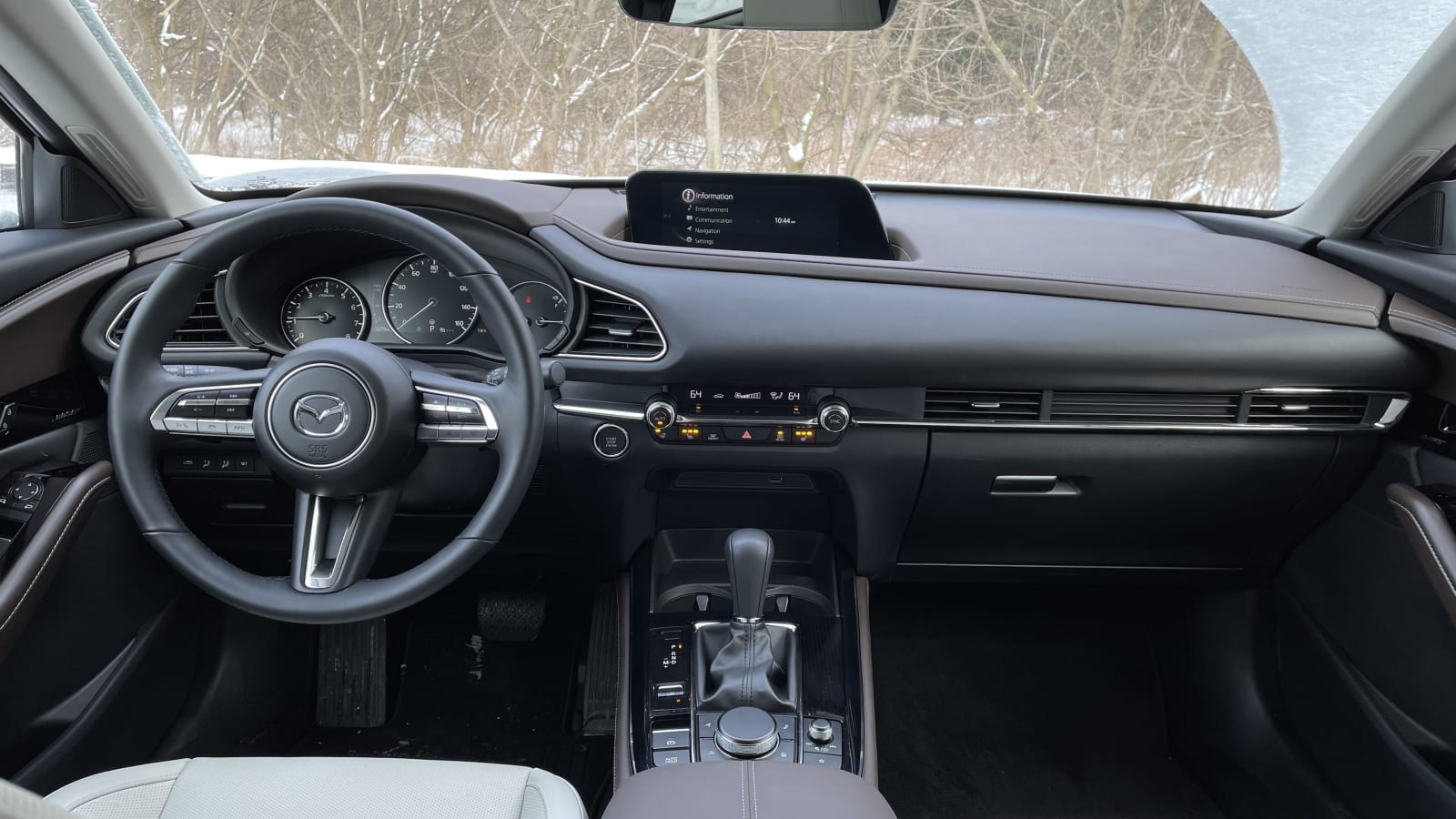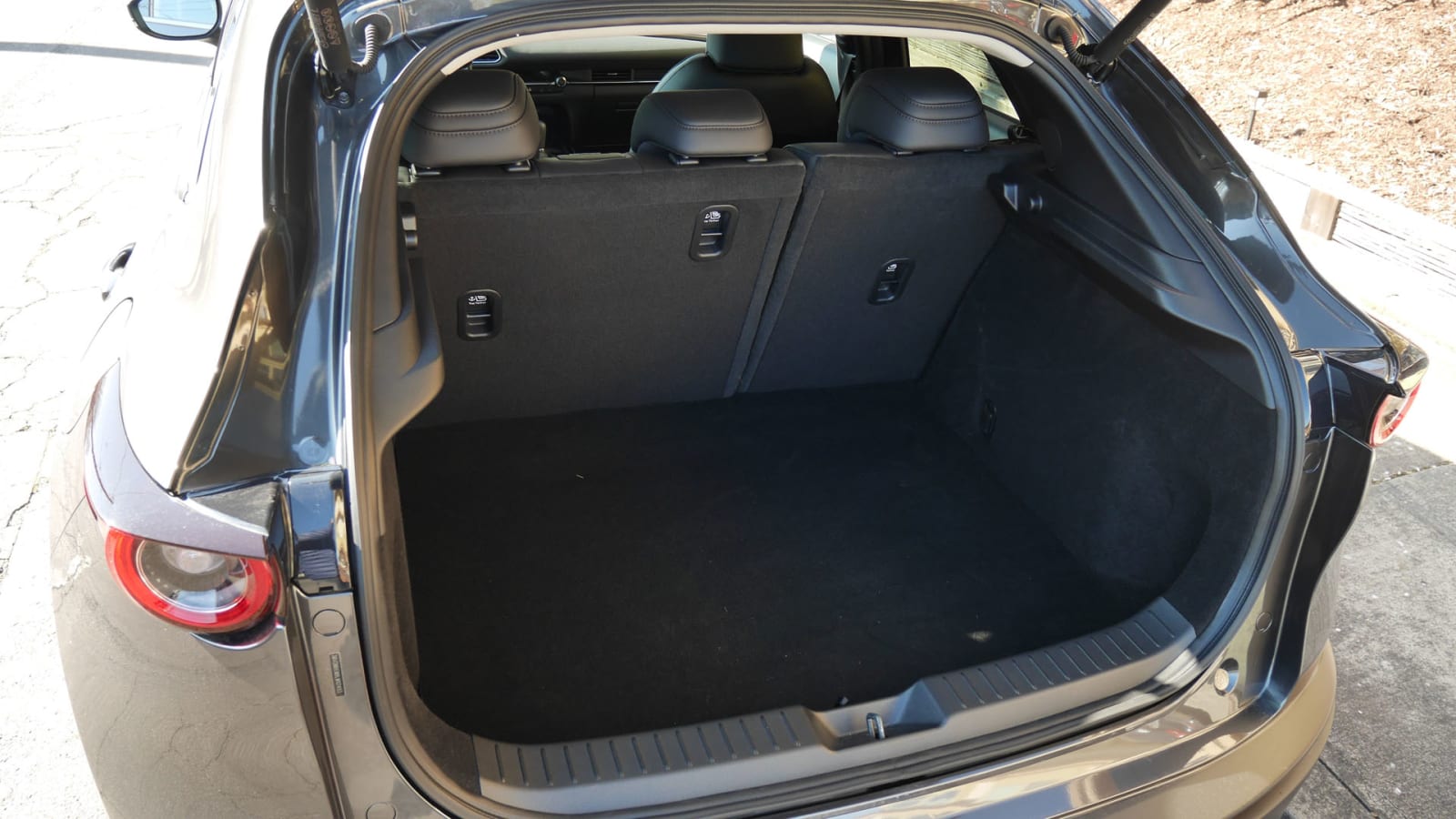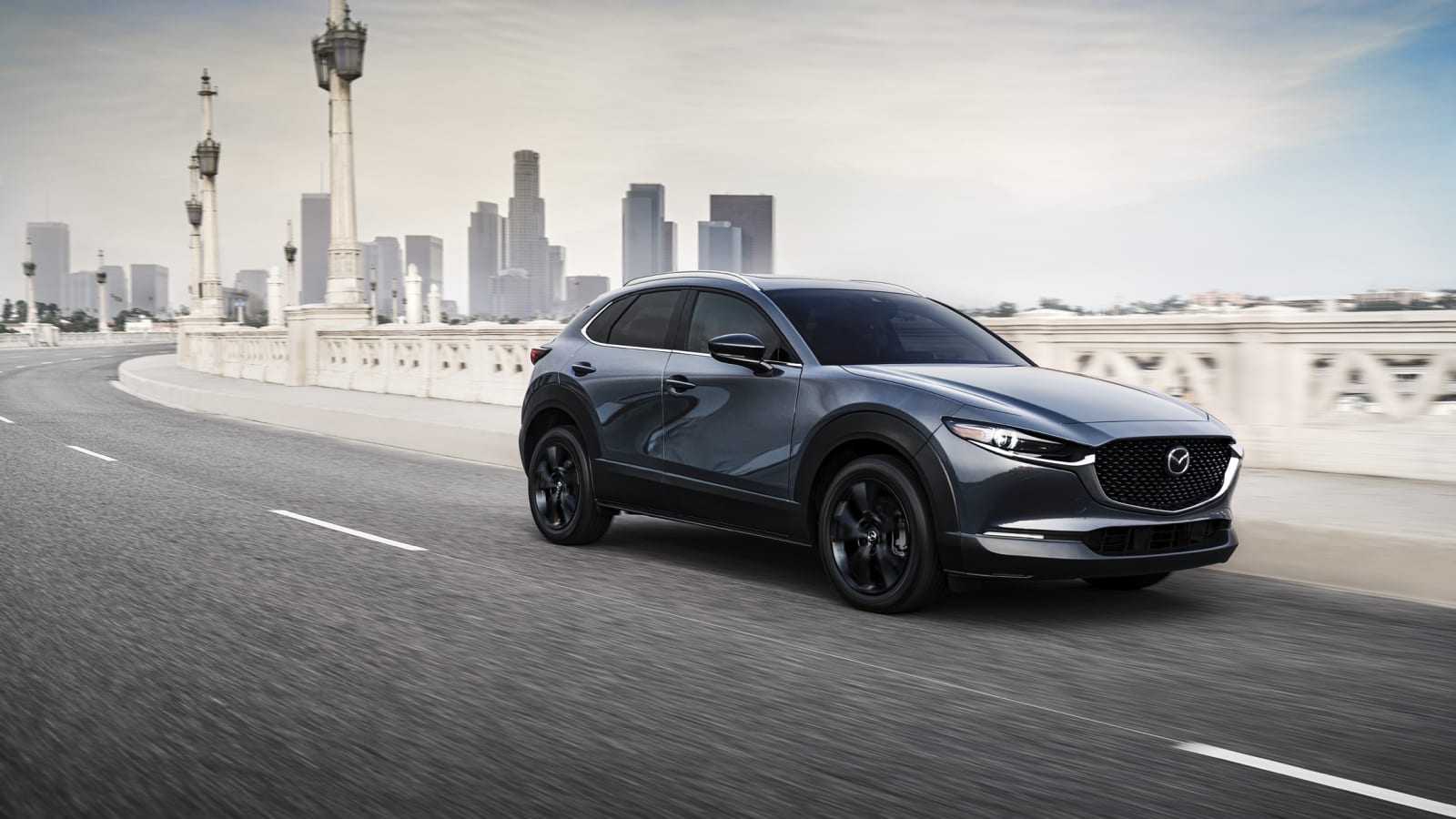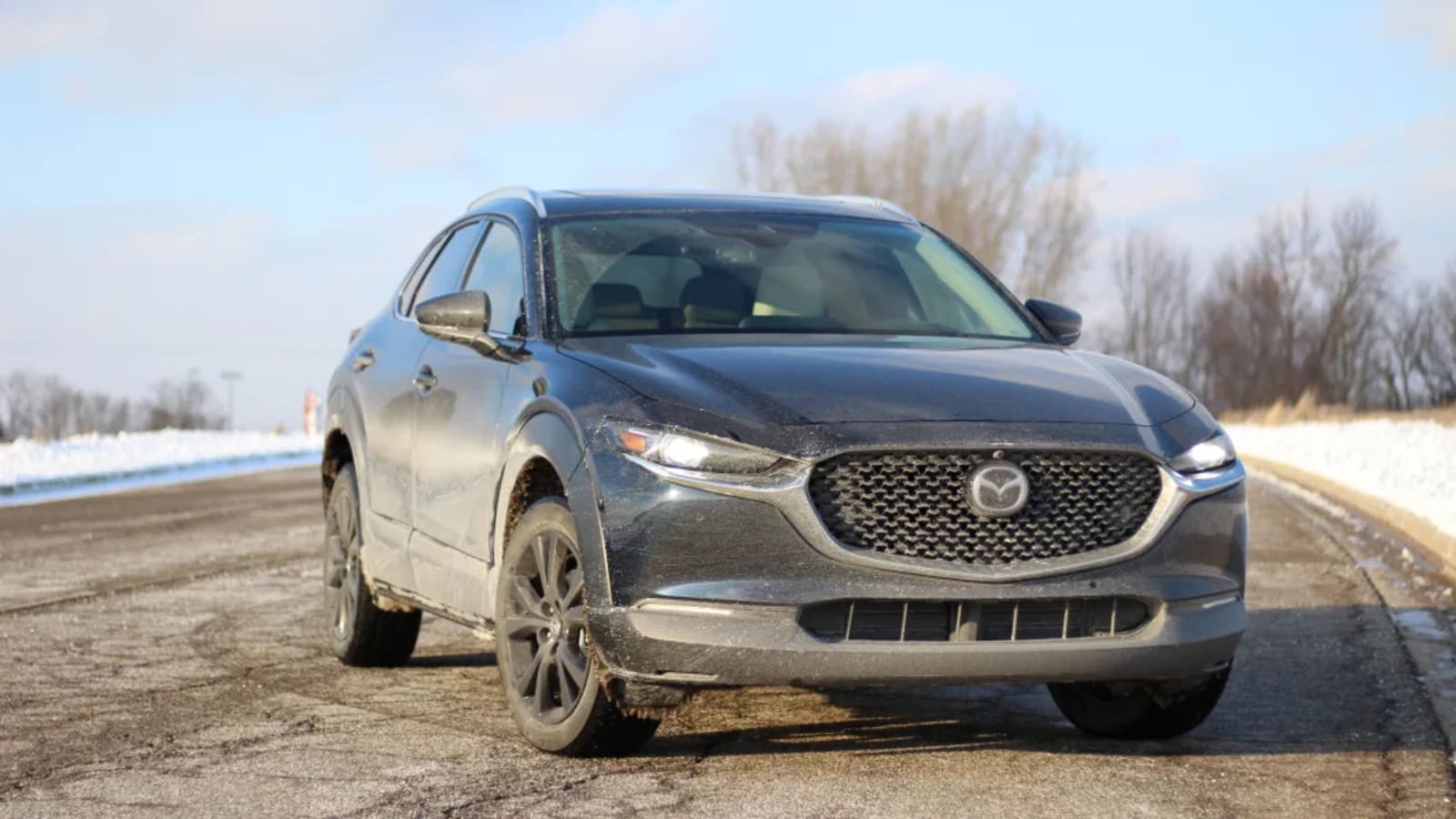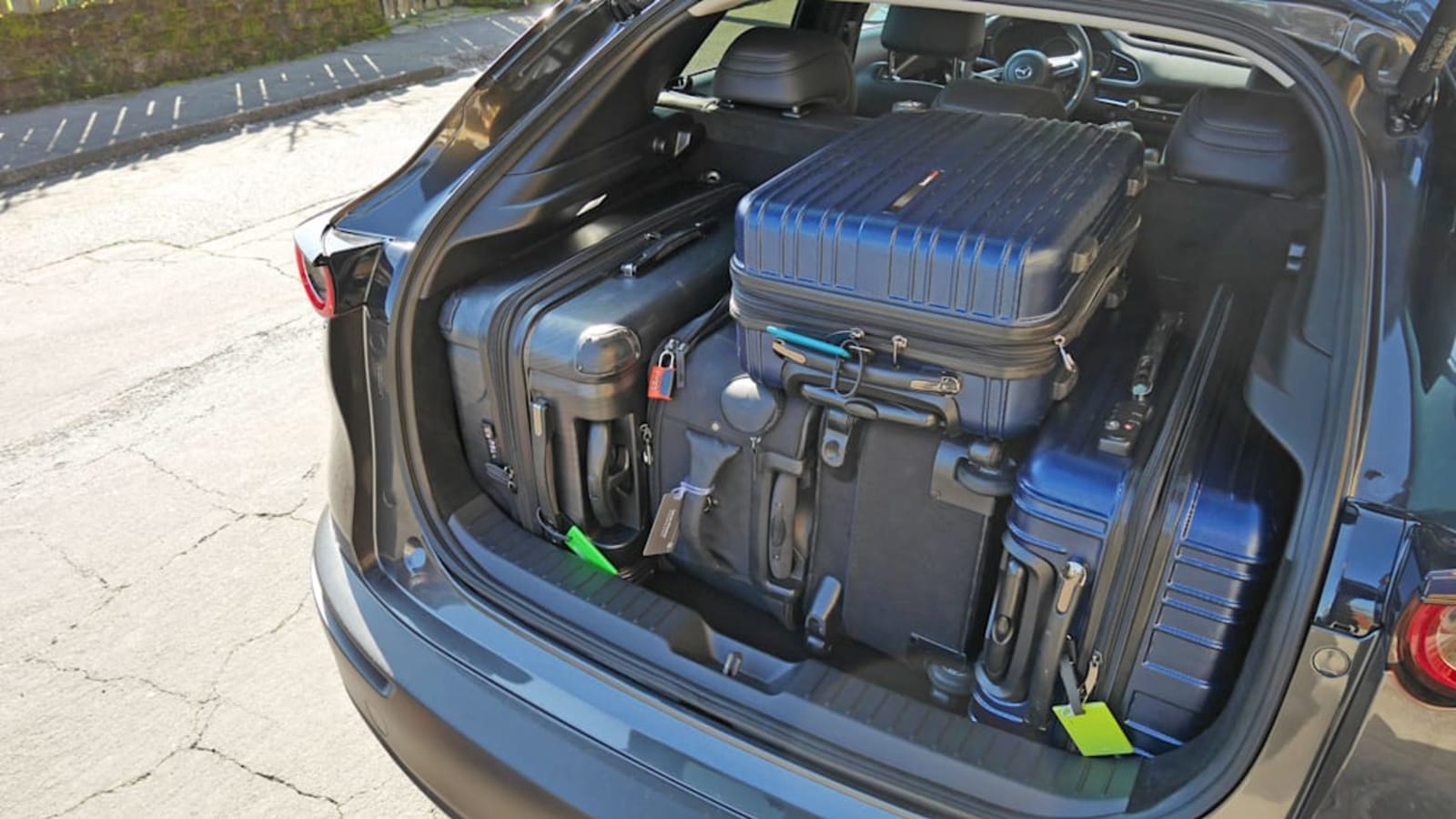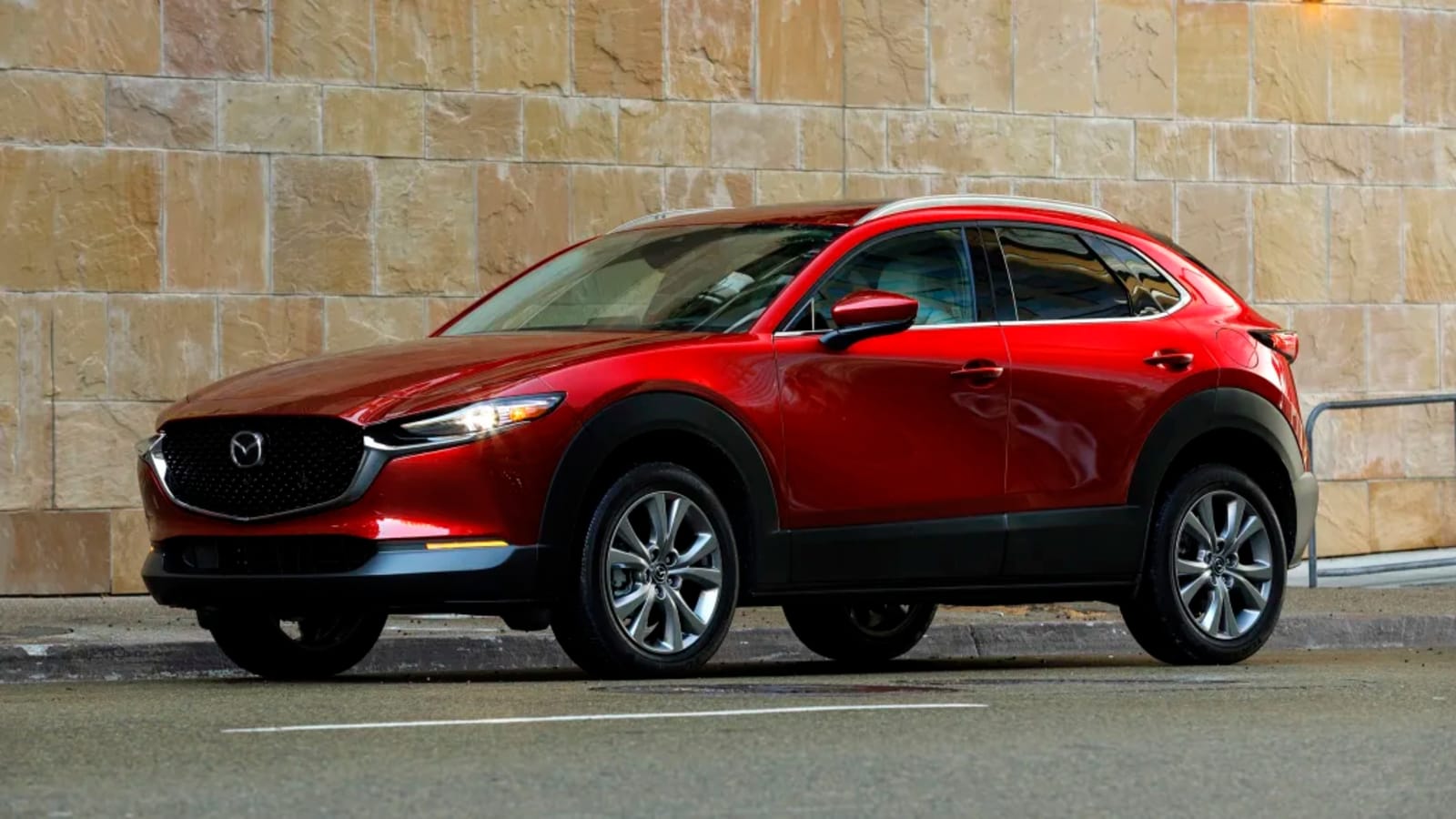Pros: Fun to drive; wonderful interior; standard all-wheel drive; class-leading turbo power
Cons: Average fuel economy from base engine; expensive relative to mainstream competitors; smartphone integration is only so-so
Mazda’s ongoing push to be an upscale brand is perhaps best exemplified by one of its least-expensive models. The 2023 CX-30 goes above and beyond the typical mainstream midcompact with a segment-busting turbocharged engine, standard all-wheel drive and an interior that belongs in a class above most of Mazda’s traditional competitors.
As impressive as it may be in that context, Mazda’s advantages come at a price — literally. It’s expensive for the segment and a bit shy when it comes to passenger and cargo space; a Kia Seltos or VW Taos would serve you better in that regard. And although it’s based on the traditionally athletic and nimble Mazda3, its AWD and taller profile add mass higher than where you’d ideally want it. Gone are the days of Mazda chasing lap times with its turbocharged Mazdaspeed models, but the CX-30 is nonetheless an excellent driving companion with near-luxury bona fides to boot.
Interior & Technology | Passenger & Cargo Space | Performance & Fuel Economy
What it’s like to drive | Pricing & Features | Crash Ratings & Safety Features
What’s new for 2023?
In short, not much. The standard 2.5-liter engine was massaged slightly, freeing up an additional 5 horsepower and simultaneously improving fuel economy, albeit slightly. Mazda also made some updates to the CX-30’s safety systems and crash structure that should improve performance for rear passengers. The only bad news is that Mazda quietly discontinued the base turbo trim, so you’ll have to spend a bit more to get that extra power for 2023.
What are the CX-30 interior and in-car technology like?
Like the Mazda3 with which it shares so much, the CX-30’s cabin makes you go “wow” considering its price and the vehicles with which it competes. Whatever trim level you’re considering, the key to this wow factor is how Mazda’s current interior design scheme removes visual clutter by reducing switchgear and effectively hiding air vents and door handles. Lower trim levels are sadly no longer available with two-tone color treatments (we suppose most people just want plain-old black), but upper trims can still get white or black leather accented with reddish brown simulated leather trim. No matter the trim level, though, for a car in the $20,000-$35,000 range, CX-30 interior looks and feels special.
It’s also of a high quality and quite functional. The steering wheel, which looks sensational, is an absolute treat to hold and has intelligently designed buttons/switches for the infotainment and cruise controls. There’s considerable center console space, including a configurable under-armrest bin, and a decently sized forward bin for a smartphone.
Mazda’s tech interface is a bit love-it-or-hate-it. The dashtop screen is large and easy to see. The knob that controls it is large, not unlike BMW’s iDrive, and ergonomically placed on the center console. It’s not a touchscreen, though, as Mazda engineers determined that hunting for touch-operating icons can be distracting. They’re not wrong, and the higher-mounted screen is certainly easier to read at a glance. That said, there are a lot of people who don’t not care for this setup and specifically prefer a touchscreen like the ones offered in all the Mazda’s competitors. Specifically, the lack of a touchscreen can make it harder to select icons in Apple CarPlay and Android Auto, which were designed to be controlled by touch. There’s a reason the Mazda CX-50 now allows touch operation when using CarPlay and Android Auto, but that advancement unfortunately hasn’t made it to the CX-30 yet.
How big is the CX-30?
Although it was originally an unusual size, the CX-30 now finds itself among a growing number of midcompact SUVs that slot in between subcompacts like the Hyundai Kona and compacts like Mazda’s own CX-5. Others include the Ford Bronco Sport, Kia Seltos, and Volkswagen Taos. In terms of space, the CX-30 is the smallest of that group and is definitely the least family-friendly. Two tall passengers will be able to sit front-to-back on the passenger side, but not on the driver side. Fitting a rear-facing child seat in the middle will be a squeeze.
Cargo space with the rear seat raised is 20.2 cubic feet, which is only a bit better than subcompact models and considerably less than the midcompacts mentioned above. That number is virtually identical to the Mazda3 hatchback, but in our testing, we found the CX-30’s extra height allowed it to swallow an additional suitcase (surprisingly, the Mazda3 sedan can carry more than them both). Although its suitcase count trailed its midcompact competitors, it was superior to a pair of small luxury models, the BMW X2 and Audi Q3. We could also fit a golf bag diagonally across the cargo area.
What are the CX-30 fuel economy and performance specs?
For 2023, every CX-30 comes with all-wheel drive, plus a six-speed automatic. There are then two choices of engine. Cars dubbed CX-30 2.5 S have a naturally aspirated 2.5-liter inline-four that produces 191 horsepower and 186 pound-feet of torque. That’s more than the base engines of most competitors, plus some of their engine upgrades. It now returns 26 miles per gallon city, 33 mpg highway and 29 mpg combined. Those figures remain low compared to other base engines, but again, the competition generally has less power.
As for the CX-30’s upgrade engine, nothing in the segment can touch it. The turbocharged 2.5-liter inline-four produces 227 hp and 310 lb-ft on regular gas. It’ll do 250 hp and 320 lb-ft if you feel like filling it with 93 octane. Fuel economy is basically the same as the base engine at 22/30/25 mpg.
What’s the CX-30 like to drive?
If you want to feel what a car is doing through the steering wheel, throttle pedal and through the seat of your pants, the Mazda CX-30 is exactly the type of small crossover you’re looking for. Its taller stature means it loses some of the agility provided by the lower Mazda3, but the primary control efforts and feedback are just as exceptional. When it comes to providing an engaging driving experience, no SUV comes remotely close in the CX-30’s price range. There’s even a case to be made that it provides more driving fun than a BMW X2.
Along those lines, the available turbo engine is there to make the CX-30 feel luxurious and effortless, rather than burn rubber and set lap times like some turbocharged Mazdaspeed of old. On paper and in practice, none of its non-luxury competitors can touch it in a straight line – it obviously costs more, but it’s the engine we’d certainly want.
Nevertheless, the base engine is still a peach. It’s more powerful than most competitors, boasts terrific throttle response and is paired with one of the smartest transmissions around. It always knows exactly which of its six gears to select at any given time, and when Sport mode is selected, it quickly downshifts when braking into a corner like the sport-tuned transmissions of luxury brands do. It also doesn’t clumsily hang onto revs when accelerating thereafter. As a bonus, the Premium trim adds paddle shifters then let you have some extra fun if you’re so inclined.
What other Mazda CX-30 reviews can I read?
2021 Mazda CX-30 2.5 Turbo First Drive | A lifted, almost-hot hatch
The turbo engine was a new addition last year. It makes an already fun little SUV, even better, though certainly not to hot hatch levels.
2020 Mazda CX-30 Luggage Test | Can it fit more than the Mazda3?
Taking an in-depth look at the CX-30’s cargo capacity to see how much luggage it can fit inside and how that compares to the Mazda3 as well as other small crossovers. We also compared it to both the Mazda3 hatch and sedan with surprising results.
2020 Mazda CX-30 First Drive | The middle way
Our first taste of the CX-30 features more in-depth information about its design and engineering.
What is the 2023 CX-30 price?
The base CX-30 2.5 S comes standard with 16-inch alloy wheels, automatic LED headlights, automatic wipers, adaptive cruise control, a full suite of accident avoidance tech (see Safety section below), cloth upholstery, two USB ports, an eight-speaker sound system, Apple CarPlay, Android Auto and the Mazda Connect interface that includes an 8.8-inch display and center console controller.
From there, you have a choice of three “packages” that are pretty much what other brands refer to as trim levels. We think the Select is best place to start your CX-30 shopping as for an extra $2,300 you gain 18-inch wheels, blind-sport warning, proximity entry, dual-zone climate control, rear air vents, a rear armrest, a leather-wrapped steering wheel, and leatherette upholstery versus the standard cloth. The Preferred, new Carbon Edition (pictured below) and Premium packages add further luxuries, most notably a heated power driver seat with memory (Preferred) and leather upholstery (Premium).
All new prices are below and include the $1,275 destination charge (add another $45 if you’re shopping in Alaska).
- S: $24,225
- S Select: $26,525
- S Preferred: $29,495
- S Carbon Edition: $30,565
- S Premium: $32,775
- Turbo Premium: $35,075
- Turbo Premium Plus: $36,675
What are the CX-30 safety ratings and driver assistance features?
Every CX-30 comes with a comprehensive array of standard safety features beyond the usual airbags and stability aids. These include forward collision warning and automatic emergency braking (Smart Brake Support), lane-departure warning, lane-keeping assist, and a driver inattention warning system. Blind-spot and rear cross-traffic warning are included on all but the base trim.
Beyond their simple inclusion, these features are also among the best-executed on the market. Most appreciably, they aren’t prone to false alarms or constantly beep at you like a scolding nanny.
The government awarded the CX-30 a perfect five stars in every crash test even before the updates Mazda made for 2023. The Institute for Highway Safety named the CX-30 a Top Safety Pick. It received the best-possible ratings in all crash tests and for its front-crash prevention system (both for vehicle-to-vehicle and vehicle-to-pedestrian accidents). Unusually, its base LED headlights got the best possible rating of “Good,” while the curve-adaptive upgrade headlights found on the range-topping Premium (photographed above) actually got a “Poor” rating due to excessive glare. The CX-30 also received top marks for the ease of use of its child seat LATCH anchors.
Related Video:


